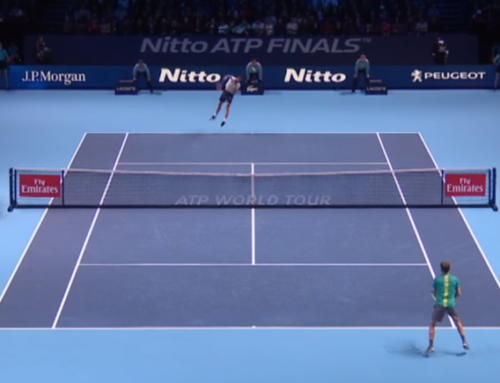One thing I’ve seen a lot of in the last decade of college coaching is players putting themselves in bad mental space to compete. This can take many forms: from setting unrealistic expectations, to poorly chosen match goals. Too often players become overly focused on the outcome of the match and in the process lose sight of the process that will give them the best chance of obtaining the result they want. In short they care about winning instead of playing well, and as a result make themselves less likely to win.
In today’s article we are going to take a look at how to set appropriate match goals in a way that enhance your on-court performance on the day. Pairing these goals with habits to improve your mental game can achieve powerful results on court. So what do I mean when I say ‘match goals’? For most people they don’t set any goals when they get on the court. They may have match expectations about whether they will win or lose. They might even have a form of goal such as “I’m going to outhit him with my forehand” or “I’m going to hit bigger serves than this guy”. The problem is that both of these example goals are poorly chosen for one simple reason: ultimately whether or not you can accomplish them is out of your control.
Here’s what we should be looking for in goals we set for our matches:
1) Set a small number of goals. You step out onto the court to play your match and you have eight goals. You want to get 70% of first serves in, play five balls to his backhand for every forehand, come into the net every time the ball bounces inside the service line, be aggressive on the return of his second serve… that’s just four and I’m already having trouble keeping track. Limit yourself to two or three goals for the match or set.
2) Set goals that are simple. “Win 59% of rallies between 4 and 9 shots” is a popular type of ‘key’ that commentators use at the Grand Slams, but who in their right mind would be counting rally lengths and tracking how many they win in the middle of a match? Keep your goals short and simple, so you can track them and know if you are meeting them or not.
3) Set goals that are largely under your control. “Hit 3 aces a game and 5 forehand winners each set” are examples of poor goals because you can’t control the outcome. What if your opponent has great defense? What if he’s a fantastic serve-returner whom is difficult to ace? Rather, set goals that you can control. Instead of “hit 2 volley winners each game” make it “come to the net twice a game”. What happens once you get there is as much up to your opponent as it is you, but if he makes two errors trying to pass you the outcome is the same as if you hit two volley winners. And if he passes you twice with great shots, there is little to be upset about. You accomplished your goal, and he came up with the goods.
4) Have a reason for each goal that you set. After all, if you’re only going to set a few goals and they are simple ones, they need to be important. Don’t set goals pointlessly over trivial things. Try to find controllable goals that drive a behavior or mentality that is important to you playing good tennis. For example I know that I play much better tennis when I am aggressive than when I am defensive. Setting a goal to approach the net twice per game drives me to look for opportunities to move forward, and if they aren’t there to create opportunities to move forward. Now with a single goal I’ve modified my mentality and match behavior in a manner that is designed to make me play better.
5) Keep track of whether or not you’re achieving your goals. And remember, this is separate from winning. You may have three simple goals, achieve them all and drop the first set. But it is important to know if you’ve achieved your goals to be able to determine whether or not they are working. Changing your plans mid-match when you don’t even know if you’ve executed your plan is a poor way to do business on the court.
To illustrate these five points, I will give an example of some match goals I might put together:
Sample Match Goals
1) Never miss 3 first serves in a row.
2) Come to the net twice every game.
3) Hit aggressive topspin returns off my opponent’s second serves
These are all simple, obtainable goals. They are largely under my control. I can track them all without needing a notebook. But what do they actually do for me?
1) Never miss 3 first serves in a row. The point of this goal is to prevent my opponent from getting a look at too many second serves in a game. If I miss two first serves, I can hit a variety of topspin serves on the third point that have an extremely high likelihood of going in. Most players are naturally more aggressive mentally returning the second serve vs the first serve regardless of what type of serve is hit. This way I avoid putting myself under too much pressure on serve (mind you my opponent might still find a way to put me under pressure).
2) Come to net twice every game. I used this in an example earlier, but this one drives a level of aggression in my behavior. It forces me to be forward thinking and look for or create opportunities to get to the net. This helps drive more aggressive play in a way that is controllable and allows flexibility for the quality of my opponent’s play. It controls aggression in a way that is very different from trying to hit winners or ‘big’ shots.
3) Hit aggressive topspin returns off my opponent’s second serves. Note that I don’t put anything in about actually making them, nor is there anything about hitting winners, or forcing errors. I can’t control whether or not those things happen. But if I hit aggressively (and the topspin pretends me from pretending I’m hitting aggressive slice returns!) then I am sending a message to my opponent that his second serve will be attacked. I don’t need to make all of them to send this message, and it will put pressure on him to either hit bigger second serves (and hence more double faults) or take take something off his first serve and make more of those (hence making for a more returnable first serve).
Put some of your own together that make sense for your game, and as always leave a comment or ask any questions you might have!


